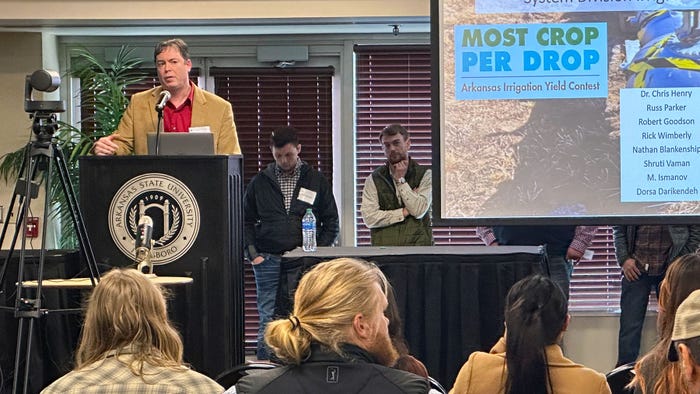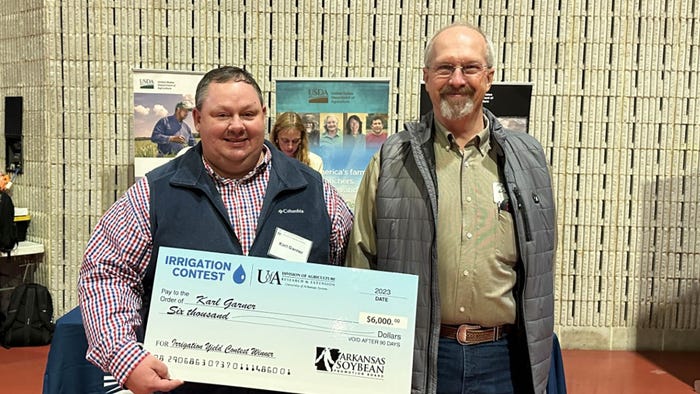
At a Glance
- In 2023, 44 producers across 24 counties in Arkansas competed in the Most Crop per Drop Irrigation Yield Contest.
- Winners were announced at the 26th annual Arkansas Soil and Water Education Conference and Irrigation Expo on Jan. 29.
- Contest winners Karl Garner and John Allen McGraw share about their irrigation management strategies.
Winners of the 2023 Arkansas Most Crop per Drop Irrigation Yield contest were announced Jan. 29 at the 26th annual Arkansas Soil and Water Education Conference and Irrigation Expo at the First National Bank Arena on the campus of Arkansas State University.
The annual irrigation contest is facilitated by the University of Arkansas System Division of Agriculture under the leadership of Chris Henry, Extension professor and water management engineer. The purpose is to recognize farmers achieving maximum and economically acceptable yield with the least amount of supplemental irrigation.
This year, the contest spanned five categories including: corn, soybean, levee rice, furrow irrigated rice, and zero-grade rice. It was the first year for zero-grace rice to be part of the challenge.
Across the Delta and Ouachita Valley of Arkansas, 44 producers competed, with nine of those submitting multiple entries. In total, there were 58 entries from 24 counties.
Henry said, “This is a big effort, and a lot of people are involved in this irrigation contest,” referring to the farmers, irrigation specialists, county Extension agents, commodity boards, NRCS staff, and industry sponsors of the competition.

Chris Henry, Extension professor and water management engineer at the University of Arkansas System Division of Agriculture, announced the 2023 Most Crop per Drop winners. Photo by: Whitney Haigwood
Most Crop per Drop winners
Henry said this irrigation contest is the only one of its kind worldwide. For the challenge, fields must be at least 30 acres, and yields must be commercially acceptable with soybean yield at least 60 bushels per acre; rice yield at least 180 bushels per acre; and corn yield at least 200 bushels per acre.
Henry said each winner used irrigation management tools like computerized hole-selection, multiple-inlet rice irrigation, soil moisture sensors and surge irrigation.
The 2023 Arkansas Most Crop Per Drop winners, receiving a cumulative total of $128,552 in prizes included:
Corn
1st place — Mark Ahrent 13.49 bushels/inch, Clay County
2nd place — John Allen McGraw, 12.4 bushels/inch, Lincoln County
3rd place — Jeremy Wiedeman, 11.95 bushels/inch, Clay County
Soybean
1st place — Karl Garner, 5.05 bushels/inch, Cross County
2nd place — John Allen McGraw, 4.80 bushels/inch, Lincoln County
3rd place — Frank Binkley, 4.14 bushels/inch, Lawrence County
Levee Rice
1st place — Stan Haigwood, 6.70 bushels/inch, Jackson County
2nd place — Rieves Wallace, 6.38 bushels/inch, Crittenden County
3rd place — Blake Ahrent, 6.36 bushels/inch, Clay County
Furrow Rice
1st place — John Allen McGraw, 6.81 bushels/inch, Lincoln County
2nd place — Seth Tucker, 6.78 bushels/inch, Drew County
3rd place — Karl Garner, 5.28 bushels/inch, Cross County
Zero-Grade Rice
1st place — Scott Whitaker, 8.23 bushels/inch, Desha County
2nd place — Chris Warren, 7.24 bushels/inch, Phillips County
3rd place — Billy Weitkamp, 7.20 bushels/inch, Randolph County
The first-place winners in the corn and soybean categories received $8,000 each; second-place winners, $3,000 each; and third-place winners, $1,000 each.
Rice winners received a RiceTec seed credit with first place receiving $14,000 each, second place receiving $9,450 each, and third place receiving $4,550 each.
Key takeaways from winners
Karl Garner, Cross County farmer and winner of the soybean category said water in his area of the state is scarce, and his focus is to conserve as much as possible. Garner has entered this competition since 2017, and he is the second producer in the history of Most Crop per Drop to win first place in the categories of corn, soybean, and rice.

Karl Garner (left), farmer in Cross County, Ark., has entered the Most Crop per Drop Irrigation Yield Contest since 2017. This year, he took first place in the soybean category, making him the second farmer in contest history to achieve top honors in all categories of corn, soybean, and rice. Photo by: University of Arkansas System Division of Agriculture
When asked why he enters this irrigation challenge, Garner said, “Because I want to see where I fit in with other farmers and learn what we can do better.”
He encouraged other farmers to learn more and adopt irrigation strategies available through their land grant institutions.
Garner said, “If you will get the tools they have for us to use and manage them properly, you will save water which in turn, saves us money.”
John Allen McGraw is a Lincoln County farmer who has also participated in the irrigation challenge for several years. In an interview with Farm Press, McGraw shared how his participation has shaped his water management.
McGraw said, “The contest is usually on a small acre field, so if you get something wrong, it won’t be catastrophic to the whole operation. It really makes you push your limits to see how far is too far and has helped me on irrigating the rest of my farm knowing that the old ways of watering are probably too much.”

Irrigation contest winner, John Allen McGraw (left), farmer in Lincoln County, Ark., is pictured with Lincoln County Extension Staff Chair Steven Stone (center) and County Extension Agent John Farabough (right). Photo by: University of Arkansas System Division of Agriculture
In 2023, McGraw won in three categories: 1st place, row rice; 2nd place, corn; 2nd place, soybean. He expressed his thanks to Henry and the sponsors of the contest.
How did McGraw manage to win so many categories? He said the keys to his success were using Pipe Planner along with soil moisture sensors.
“Pipe Planner is kind of the ace in the hole for the contest and being overall efficient. I use it on all 100% of irrigated ground,” McGraw reported. “Without Pipe Planner and soil moisture sensors, it would be a lot of guessing and very hard to make a plan according to the weather.”
For his winning row rice field, McGraw reported irrigating two times per week for approximately 12 hours per set, and he stopped up the field to catch every inch of rain, with no runoff. His corn and soybean fields were irrigated around three to four times during the growing season.
Henry stressed that management is key in this competition. He said, “The key to success with irrigation seems to be the management, the irrigation water management tools are aids, not silver bullets. If a grower puts the same effort into managing irrigation as their other inputs, they can be very successful.”
For details on the contest and annual reports from past years, you can visit the Arkansas Cooperative Extension irrigation webpage at https://uaex.uada.edu/irrigation.
About the Author(s)
You May Also Like






